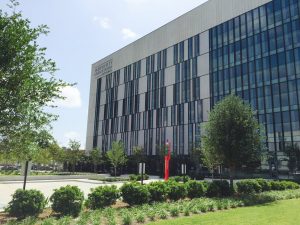
When Hurricane Katrina flooded New Orleans, Charity Hospital was destroyed. After the storm, officials from the state and from Louisiana State University, which ran the hospital, evaluated the building and deemed it had been too damaged by water and mold to reopen. The Louisiana State University System choose instead to incorporate it into the new University Medical Center currently being constructed. The new University Medical Center (UMC) will combine academics and science to provide comprehensive treatment and trauma services as well as graduate medical education programs for future generations.
BHATE Geosciences was selected to be on the LSU UMC project team based on our extensive experience with deep foundations. The project consisted of three systems with over 9,000 precast prestressed concrete, timber and composite piles (800,000 LF) with 6 pile rigs working simultaneously.
The 446-bed hospital is a 560,000 SF concrete and steel-framed structure designed to meet flood-resistant construction standards built 22 feet above sea level with a 1,300-car parking deck. Buildings were constructed to withstand a Category 3 hurricane as well as nuclear, chemical or biological accidents, physical attacks, fires and radiation hazards.
BHATE established an onsite lab operating 24/7 during pile installation and provided geotechnical documentation, noise and vibration monitoring, IBC Special Inspections, test piles and production piles, pile driving monitoring and recording and observation of pile foundations.
We are proud to be part of such a significant project (construction costs of $1.1 billion) that will provide care to so many New Orleans residents as well as teach future generations of doctors and medical professionals.

